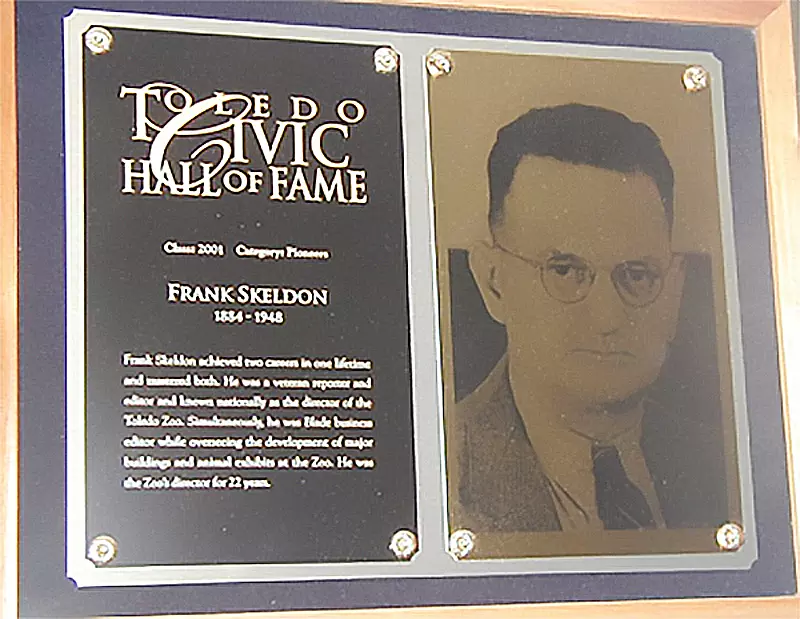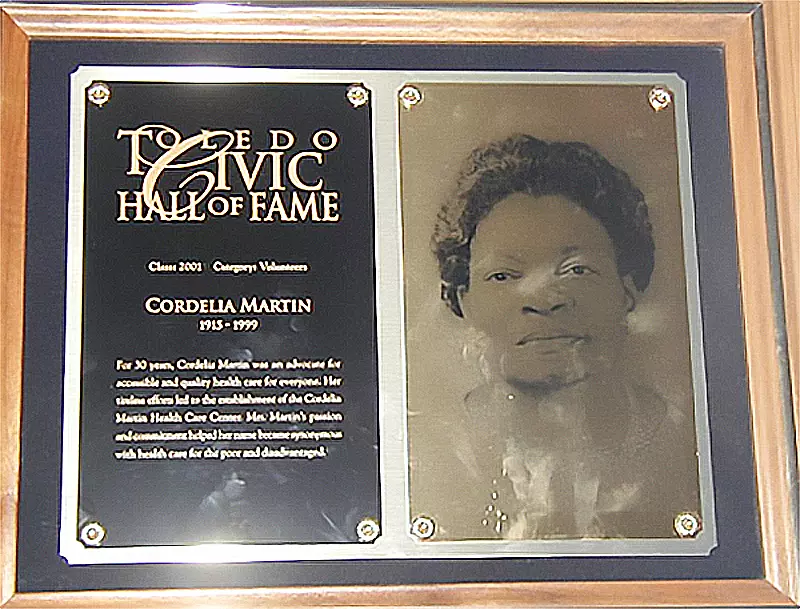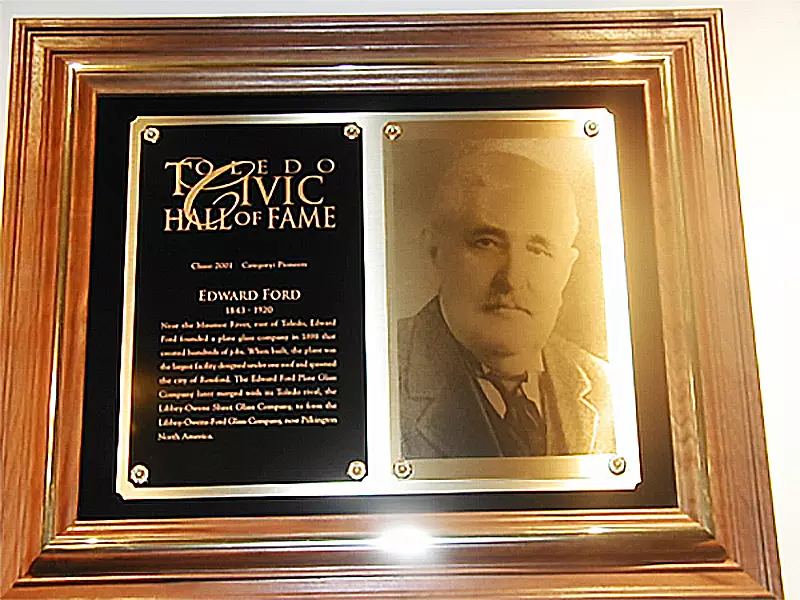2001 Inductees
Emory Leverette (1915-1996), Volunteer
Leverette graduated from Alabama State College in Montgomery and received his master's degree from the University of Michigan. At age 29, he became the Toledo Public Schools' first African American administrator, serving as assistant principal at Gunckel Elementary School. At that time, African-American teachers were only allowed at that school. Toledo's peaceful, voluntary school desegregation process is due largely to Leverette. Leverette became principal of Gunckel in 1955, and administrative assistant to the district superintendent in 1967. During the 1970's, the district launched a voluntary desegregation plan, avoiding any court-ordered desegregation. Leverette Junior High was named in his honor in 1980.
Cordelia Martin (1915-1999), Volunteer
Cordelia Martin raised twelve children with her husband, Walter, but considered all the neighborhood children her own. As a volunteer with the Model Cities Neighborhood Residents Association, she was disturbed by the lack of available heath care for the disadvantaged. After years of effort, the Cordelia Martin Health Care Center opened in 1971 on Nebraska Avenue. In 1997, the Center served about 20,000 elderly, low-income, and non-insured people. Martin received a degree from the University of Toledo and worked for eighteen years as a social worker for Planned Parenthood. She was active in the NAACP and the Frederick Douglas Community Center.
Edward Ford (1843-1920), Pioneer
Ford was born in Greenville, Indiana. His father, John Baptiste, owned the first company to manufacture plate glass in the United States, using machinery imported from England. Edward followed him into the business, working for him in Pennsylvania and establishing plate glass companies in Columbus, Ohio, and Indiana before moving to Toledo in 1898. The wide, empty plain along the Maumee River just east of Toledo beckoned and he opened the Ford Plate Glass Company on 173 acres there in 1898. It was the largest factory in the country under one roof. The town of Rossford sprang up alongside it (its name coming from Ford and wife Carrie's maiden name). The company merged later to become Libbey-Owens-Ford and is now part of Pilkington. Ford died at age 77 at his home on Collingwood Avenue and is buried in Woodlawn Cemetery.
Frank Leroy Skeldon (1884-1948), Pioneer
 Frank Leroy Skeldon (1884-1948)
Frank Leroy Skeldon (1884-1948)
Born in North Toledo, Frank followed his father's footsteps and became a tugboat fireman in his teens. At seventeen, he attempted boxing, was promptly knocked out, and found employment as an office boy at the Toledo News-Bee. He began his reporting career shortly after, and joined The Blade in 1902. He scooped the Titanic story by using his marine skills to meet the tug loaded with survivors offshore, a full hour ahead of other reporters. Throughout his 47 years as a newspaperman, he always enjoyed reporting best, eschewing administrative duties whenever possible. In 1905 he was assigned to write a story about animals that had escaped from the Toledo Zoo. As a South Side resident, he had followed the new zoo's progress. He joined the zoological society, became secretary of the society and later director of the zoo in 1926. He remained director until his death in 1948. Skeldon had abundant plans for expanding the zoo, and in the 1930's, when New Deal programs sought employment projects in Toledo, Skeldon was waiting. The zoo amphitheater, reptile house, aviary, aquarium and tunnel under Anthony Wayne Trail were built at this time, putting 1,300 laborers to work. Skeldon was also skilled at coaxing labor unions to help supply needed materials for zoo projects. Many zoo buildings were made out of reclaimed materials. Carvings were sculpted out of blocks from old Erie Canal locks. Despite Skeldon's modesty, he was awarded numerous honors and accolades by the press. When he died at age 64 of cancer he was widely praised.
Charles A. Dana (1881-1975)
Dana grew up in New York City, where he earned his law degree at Columbia University. He practiced law for ten years and served three terms on the New York State Legislature. In 1914 he purchased control of Spicer Universal Joint Manufacturing Inc., an innovative but struggling New Jersey company. Dana oversaw management of the firm, which grew under his guidance and gradually demanded most of his time. In 1929 the company was moved to Toledo to be near Detroit's automotive industry. The company was renamed the Dana Corporation in 1946. Dana retired as chairman of the board in 1966, devoting most of his time to the Charles A. Dana Foundation, a private, philanthropic foundation funding projects in science, health and education. One of the Foundation's hallmark "challenge gifts" (requiring recipients to raise one-third or one-half the amount granted) resulted in the University of Toledo's engineering science building. Dana was known for his frugality and concern for his employees.
Marvin Kobacker (1911-1993)
Kobacker's father, a Lithuanian immigrant, opened his first store in Pennsylvania when he was eighteen years old. The Kobacker's chain grew to include thirteen stores in Ohio and New York. In 1925, he purchased Tiedtke's Department Store in downtown Toledo. His son's work in various stores was interrupted by World War II. Marvin returned from the Navy to manage Tiedtke's. He became vice-president in 1946 and president in 1952. Kobacker was an enthusiastic booster of downtown Toledo, and worked with business leaders to keep the downtown area vibrant. His influence on the arts in Toledo was profound. He served as president of the Toledo Museum of Art and the Toledo Symphony. He made substantial donations to the art museum and built the large performance hall at Bowling Green State University named after him. He actively worked for county mental health boards and served as president of the Lucas County Board of Mental Health and Mental Retardation. He contributed $1.2 million to the Kobacker Center at the Medical College of Ohio, a residential treatment center for youth.
James Nicholson (1905-1983)
Trained as a lawyer, Nicholson never practiced law. His young adulthood was dedicated to coaching football and basketball at his alma mater, Sandusky High School. He joined the University of Toledo in 1930 as its first full-time football coach. When he retired from the University in the mid-1930's and his assistant coach was not hired to replace him, the two men went into the concrete business together. He continued to support athletic programs at the University and throughout Toledo. He also headed three public school levy campaigns.
Edward "Ned" Skeldon (1924-1988)
The son of Frank Skeldon, "Ned", grew up in South Toledo and played football for Central Catholic High School and the University of Toledo. He joined the Navy in World War II, and worked for former Toledo Mayor Michael DiSalle in Washington D.C., before returning to Toledo to pursue local politics. He served as vice-mayor of Toledo and four terms as president of the Lucas County Board of Commissioners, from 1958 to 1966. For thirteen years, he was head of Clear Water Inc., an organization dedicated to cleaning the Maumee River. He was also vice chair of the Ohio Water Development Authority, a state-wide environmental agency. As a member of the Lucas County Recreation Inc., he was instrumental in bringing the Mud Hens back to Toledo in 1965. The Mud Hens Stadium was renamed in his honor in June of1988, three months before his death.



